Subaru Forester
| Subaru Forester | |
|---|---|
_2.5i_AWD_wagon_(2018-10-08)_01.jpg) | |
| Overview | |
| Manufacturer | Subaru |
| Production | 1997–present |
| Assembly |
|
| Body and chassis | |
| Class | Compact crossover SUV |
| Body style | 5-door SUV |
| Layout | Front-engine, four-wheel drive |
| Related | Subaru Impreza |
| Chronology | |
| Predecessor | Subaru Bighorn (Isuzu) |
The Subaru Forester is a compact crossover SUV (sport utility vehicle) manufactured since 1997 by Subaru. Available in Japan from 1997, the Forester shares its platform with the Impreza. It has been awarded Motor Trend's 2009 and 2014 SUV of the Year and The Car Connection's Best Car To Buy 2014.[2]
First generation (SF, 1997–2002)[edit]
| First generation | |
|---|---|
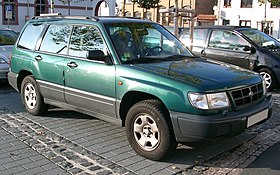 | |
| Overview | |
| Production | 1997–2002 |
| Body and chassis | |
| Related | |
| Powertrain | |
| Engine | |
| Transmission | |
| Dimensions | |
| Wheelbase | 2,525 mm (99.4 in) |
| Length | 1997–2000: 4,450 mm (175.2 in) 2000–2002: 4,460 mm (175.6 in) |
| Width | 1,735 mm (68.3 in) |
| Height | 1,650 mm (65.0 in) |
| Curb weight | 1,430 kg (3,152.6 lb) |
The Forester was introduced at the Tokyo Motor Show in November 1995 as the Streega concept, and made available for sale February 1997 in Japan, and to the US market in 1997 for MY1998. The Forester was one of the first emerging crossover SUVs.[3] It was built in the style of a car, but had a taller stance, higher h-point seating, and an all-wheel drive drivetrain. Subaru advertising employed the slogan "SUV tough, Car Easy". It used the Impreza platform but with the larger 2.5-liter DOHC EJ25D four-cylinder boxer engine from the Subaru Outback, making 123 kW (165 hp; 167 PS) at 5,600 rpm and 220 N⋅m (162 lb⋅ft) of torque at 4,000 rpm.
In Japan, the Forester replaced the Subaru Impreza Gravel Express, known in the US as the Subaru Outback Sport. However, the Outback Sport remained in production for the U.S. market. The Forester appeared after the introduction of the Nissan Rasheen in Japan with a similar appearance, and the Forester's Japanese competitors include the Toyota RAV4, Mitsubishi RVR, and the Suzuki Grand Vitara. Due to the Forester's low center of gravity, it meets the United States federal safety standards for passenger vehicles, and does not require a "risk of rollover" warning label on the driver's visor. Size and price-wise, it fits between the shared Impreza platform, and the larger Legacy.
The automatic transmissions used on AWD equipped vehicles will normally send 60% of the engine's torque to the front wheels and 40% to the rear wheels, using a computer-controlled, continuously variable, multi-plate transfer clutch. When the transmission detects a speed difference between the front and rear axle sets, the transmission progressively sends power to the rear wheels. Under slip conditions it can achieve an equal split in front and rear axle speeds.[4]
When accelerating or driving uphill, the vehicle's weight shifts rearward, reducing front wheel traction, causing the transmission to automatically send torque to the rear wheels to compensate. When braking or driving downhill, the vehicle's weight shifts towards the front, reducing rear wheel traction. The transmission again compensates by sending torque to the front wheels for better steering control and braking performance. If the automatic is placed in reverse or first gear, the transmission divides the torque 50/50 to both front and rear wheels.[citation needed] The manual transmission cars are set up with a near 50/50 torque split as a base setting, and it varies from there. Essentially, the manual cars are set up with more bias towards the rear than the automatic cars.
The trim levels were the basic model "L" and the fully equipped "S" for the USA versions.
Forester L came with a high level of standard equipment, including ABS, air conditioning, power windows, power locks, cruise control, digital temperature gauge, multi-reflector halogen headlights, fog lights, roof rack, rear window defogger, trailer harness connector, reclining front bucket seats with adjustable lumbar support, tilt steering, tinted glass, AM/FM/cassette stereo with its antenna laminated in the left-rear quarter window. Notably new in 2001 were the three-point seatbelts for all five seating positions, including force limiters in front and height-adjustable shoulder belt anchors for front and rear outboard positions, plus rear seat headrests for all three seating positions.
Forester S adds a viscous limited-slip differential, rear disc brakes, 16 × 6.5-inch alloy wheels with 215/60R16 tires (the L uses 15 × 6-inch steel wheels), upgraded moquette upholstery, heated front seats with net storage pockets in back, dual vanity mirrors, heated sideview mirrors, heated windshield wipers, and keyless entry. New equipment for 2001 included Titanium pearl paint for the bumpers and cladding; six-disc in-dash CD sound system; leather-wrapped steering wheel, shift knob and handbrake handle; variable intermittent wipers with de-icers and driver's side fin; and the five-spoke alloy wheels. Some models were equipped with the $1,000 optional premium package on the Forester S, including monotone paint (Sedona Red Pearl), power moonroof, front side-impact airbags, and gold accent wheels. Other options were the $800 automatic transmission, $39 chrome tailpipe cover and $183 auto-dimming rear-view mirror with compass, bringing the sticker price to $25,412 including $495 delivery (U.S. dollars quoted).
Australia[edit]
There was a change in body styling for all 2001–2002 models, and the 2001/2002 GT spec also had a change in engine management and power output was increased from 125 to 130 kW (174 hp; 177 PS).
- GX - naturally aspirated 2.0-liter flat-4, 92 kW (123 hp; 125 PS)
- Engine size 1,994 cc (2.0-liter)
- Compression ratio 9.7:1
- Dual range gearbox - manual only
- Acceleration 0–100 km/h (0-62 mph) 10.7 seconds
- Limited - naturally aspirated 2.0-liter flat-4, 92 kW (123 hp; 125 PS)
- Engine size 1,994 cc (2.0-liter)
- Compression ratio 9.7:1
- Dual range gearbox - manual only
- Acceleration 0–100 km/h (0-62 mph) 10.7 seconds
- Special Edition - naturally aspirated 2.0-liter flat-4, 92 kW (123 hp; 125 PS)
- Engine Size 1,994 cc (2.0-liter)
- Compression Ratio 9.7:1
- Dual range gearbox - manual only
- Acceleration 0–100 km/h (0-62 mph) 10.7 seconds
- GT (1997–2000) - turbocharged 2.0-liter flat-4, 125 kW (168 hp; 170 PS)
- GT (2000–2003) - turbocharged 2.0-liter flat-4, 130 kW (174 hp; 177 PS)
- Engine size 1,994 cc (2.0-liter)
- Turbo TF035
- Compression ratio 8.5:1
- Acceleration 0–100 km/h (0-62 mph) 10.1 seconds
United States[edit]
The U.S. market was offered the car starting in 1997 with either the 2.5-liter DOHC (MY1998 only) or 2.5-liter SOHC naturally aspirated engine (no turbocharged engines). In 2000 Subaru updated the exterior with a modest facelift to the front, rear and sides, and the interior's dashboard MY2001.
MY1998 - 2000 versions sold in the United States:
- Base - Naturally aspirated 2.5-liter flat-4, 123 kW (165 hp; 167 PS)
- L - Naturally aspirated 2.5-liter flat-4, 123 kW (165 hp; 167 PS)
- S - Luxury model, with naturally aspirated 2.5-liter flat-4, 123 kW (165 hp; 167 PS)
The MY2001-2002 versions carried over adding the S Premium model, albeit with the aforementioned mild redesign:
- Base - Naturally aspirated 2.5-liter flat-4, 123 kW (165 hp; 167 PS)
- L - Naturally aspirated 2.5-liter flat-4, 123 kW (165 hp; 167 PS)
- S - Luxury model, with naturally aspirated 2.5-liter flat-4, 123 kW (165 hp; 167 PS)
- S Premium - Luxury model (upgrades over the 'S' model), Leather optional in 2002, with naturally aspirated 2.5-liter flat-4, 123 kW (165 hp; 167 PS)
Second generation (SG, 2002–2007)[edit]
| Second generation | |
|---|---|
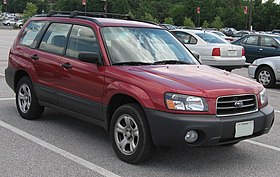 | |
| Overview | |
| Also called | Chevrolet Forester (India)[5][6][7] |
| Production | 2002–2007 |
| Body and chassis | |
| Related | |
| Powertrain | |
| Engine |
|
| Transmission | |
| Dimensions | |
| Wheelbase | 2,525 mm (99.4 in) |
| Length | 2003–2005: 4,450 mm (175.2 in) 2006–2008: 4,485 mm (176.6 in) |
| Width | 1,735 mm (68.3 in) |
| Height | 1,650 mm (65.0 in) Sports 2.5X: 1,590 mm (62.6 in) Sports 2.5XT: 1,585 mm (62.4 in) |
| Curb weight | 2.0 L: 1,320 kg (2,910.1 lb) 2.0 L turbo: 1,410 kg (3,108.5 lb) 2.5 L: 1,424 kg (3,139.4 lb) 2.5 L turbo: 1,474 kg (3,249.6 lb) |
The second generation was introduced as a 2003 model at the 2002 Chicago Auto Show, based on the new Impreza platform, featuring several fine-tune improvements over the past model. The 2003 Forester features weight-saving refinements such as an aluminum hood, perforated rails, and a hydro-formed front sub-frame. The most noticeable change was the offering of 2.5 L versions (normally aspirated and turbocharged) and in the U.S. the introduction of the turbo charged 2.5-liter model.
In the U.S., the naturally aspirated (non-turbo) X (previously L) and XS (previously S) were released in 2003. In 2004, the turbocharged XT version was released. However, the same model had been available since the late 1990s elsewhere in the world. The X and XS models feature a 2.5 L SOHC engine, while the XT model features a 2.5 L turbocharged DOHC engine. Both engines have timing belt driven camshafts.[8] The XT model uses the same Mitsubishi TD04 turbocharger used in the Subaru Impreza WRX[citation needed]. Those seeking additional power for their Forester XT can replace the turbocharger and intercooler with used STI components which are readily available. All Forester 2.5 L engines are of the interference engine type.
In 2004, Subaru launched an STI variant of the Forester, the Forester STI, for the Japanese Market, sharing the same engine as the 2005 Subaru Impreza WRX STI. Starting with the 2004 XT, the turbocharged version had active valve control system AVCS cylinder heads. The i-AVLS active valve lift system became standard on the naturally aspirated version of the Forester in 2006. This increased horsepower and torque figures to 173 HP and 166 ft-lbs. The 2006 XT received a higher compression ratio to 8.4:1 from 8.2:1. This increased the XT's power to 230 HP and 235 ft-lbs.
For the 2006 model year, Subaru gave the SG a facelift, using redesigned headlights, tail-lights, bonnet, grille, front bumper and side-moldings.
Safety[edit]
MY03-04 Models has a 4-Star ANCAP safety rating. MY05 Forester Model had a mid-life update, which update increased its ANCAP safety rating to 5 Stars.
In 2006, the turbocharged engine (powering the Forester XT) was awarded International Engine of the Year.[9][10] This engine is also used in the Subaru Impreza WRX, as well as the re-badged Saab 9-2XAero.
Maintenance[edit]
All of the 2.5-liter 4-cylinder engines for this generation have a timing belt made of rubber and cord. A belt must be replaced at 105,000 miles (169,000 km). These engines are interference engines, meaning that if the timing belt breaks or stretches, the pistons will hit the valves, resulting in an engine teardown, and a likely rebuild. Also, if this belt is replaced around 105,000 miles, it is a good idea to change the water pump, thermostat, belt tensioner and all the idler pulleys for this belt. The water pump and thermostat are behind this belt. In Australia for the Series II (MY06) cars, Subaru changed the recommended service interval for the timing belt replacement from 100,000 kilometers to 125,000 kilometers. The 2.5-liter 4-cylinder engine in the first-generation Foresters featured head gaskets which were prone to premature failure. For 2003 and later, this problem was addressed with a revised, higher performing design, but is still a problem.[citation needed]
United States[edit]
The U.S. Market was offered the car with either the 2.5 SOHC naturally aspirated engine, or the 2.5 DOHC turbocharged version added in 2004.
2004 versions sold in the United States:
- 2.5 X - Base model, with naturally aspirated 2.5 L flat-4, 165 hp (123 kW)
- 2.5 XS - Luxury model, with naturally aspirated 2.5 L flat-4, 165 hp (123 kW)
- 2.5 XS Premium - Luxury model with sunroof and leather seats, with naturally aspirated 2.5 L flat-4, 165 hp (123 kW)
- 2.5 XT Turbo - turbocharged 2.5 L flat-4, 210 hp (157 kW)
- 2.5 XT Turbo Premium - Leather seats, sunroof, Automatic Transmission only, turbocharged 2.5 L flat-4, 210 hp (157 kW)
In 2005, the L.L. Bean edition is added:
- 2.5 X - Base model, with naturally aspirated 2.5 L flat-4, 165 hp (123 kW)
- 2.5 XS - Luxury model, with naturally aspirated 2.5 L flat-4, 165 hp (123 kW)
- 2.5 XS w/Moonroof - Luxury model, with naturally aspirated 2.5 L flat-4, 165 hp (123 kW)
- 2.5 XS L.L. Bean edition - Rear self-leveling suspension, leather seats, unique wheels, 2-tone paint, wood steering wheel/shift knob, auto trans only, naturally aspirated 2.5 L 165 hp (123 kW)
- 2.5 XT Turbo - turbocharged 2.5 L flat-4, 210 hp (157 kW)
- 2.5 XT Turbo Premium - Leather seats, sunroof, turbocharged 2.5 L flat-4, 210 hp (157 kW)
In 2006, styling is updated, Active valve lift system is added to non-turbo engines to improve power and efficiency, XS model deleted, Premium model added:
- 2.5 X - Base model with naturally aspirated 2.5 L flat-4, 173 hp (129 kW)
- 2.5 X Premium - Similar to L.L. Bean, with cloth seats, different wheels, leather steering wheel/shift knob available with manual or auto trans, naturally aspirated 2.5 L, 173 hp (129 kW)
- 2.5 X L.L. Bean edition -Luxury model with L.L. Bean package, naturally aspirated 2.5 L flat-4, 173 hp (129 kW)
- 2.5 XT Limited Turbo - Leather seats, sunroof, turbocharged 2.5 L flat-4, 230 hp (172 kW)
In 2007, a bottle holder was added to front door panels, the 'Sports' trim level was added, which changed some interior and exterior features and added the VDT/VDC transmission to the XT Sports turbo Automatic model:
- 2.5 X - Base model with naturally aspirated 2.5 L flat-4, 173 hp (129 kW)
- 2.5 X Sports - Base model with updated interior and exterior features, with naturally aspirated 2.5 L flat-4, 173 hp (129 kW)
- 2.5 X Premium - Luxury model with naturally aspirated 2.5 L flat-4, 173 hp (129 kW)
- 2.5 X L.L. Bean edition -Luxury model with L.L. Bean package, naturally aspirated 2.5 L flat-4, 173 hp (129 kW)
- 2.5 XT Limited Turbo - Leather seats, sunroof, turbocharged 2.5 L flat-4, 224 hp (167 kW)
- 2.5 XT Sports Turbo - Different interior and exterior features (cloth seats, no fog lights, etc.), sunroof, turbocharged 2.5 L flat-4, 224 hp (167 kW)
In 2008, TPMS was added, L.L. Bean model deletes rear load-leveling suspension, but gains radio upgrade, the XT Turbo Limited models gets the VDT/VDC Auto transmission as well:
- 2.5 X - Base model with naturally aspirated 2.5 L flat-4, 173 hp (129 kW)
- 2.5 X Sports - Base model with updated interior and exterior features, with naturally aspirated 2.5 L flat-4, 173 hp (129 kW)
- 2.5 X Premium - Luxury model with naturally aspirated 2.5 L flat-4, 173 hp (129 kW)
- 2.5 X L.L. Bean edition -Luxury model with L.L. Bean package, naturally aspirated 2.5 L flat-4, 173 hp (129 kW)
- 2.5 XT Limited Turbo - Leather seats, sunroof, turbocharged 2.5 L flat-4, 224 hp (167 kW)
- 2.5 XT Sports Turbo - Different interior and exterior features (cloth seats, no fog lights, etc.), sunroof, turbocharged 2.5 L flat-4, 224 hp (167 kW)
Australia[edit]
The Forester had three main models available in Australia until July 2005:
- X - naturally aspirated 2.5 L flat-4, 112 kW (150 hp)
- XS - naturally aspirated 2.5 L flat-4, 112 kW (150 hp)
- XT - turbocharged 2.5 L flat-4, 155 kW (208 hp)
The Forester at the time had three main models available in Australia from August 2005 Series II:
- X - naturally aspirated 2.5 L flat-4, 121 kW (162 hp)
- XS - naturally aspirated 2.5 L flat-4, 121 kW (162 hp)
- XT - turbocharged 2.5 L flat-4, 169 kW (227 hp)
The Luxury Pack edition was an option on all models - allowing for leather seats and a sunroof. These options were also included with the Columbia edition. The Weekender edition included fog lights, roof racks and alloy wheels. Standard with the Manufacture Year 2006 (MY06) Forester came with larger side mirrors with indicator lights, curtain airbags giving a 5 star safety rating, remodelled centre console and exterior with a new look nose, lights and bumpers and the rear lost the large Subaru badge under the rear window.
- X - Air conditioning, CD player, power windows, ABS and cruise control.
- XS - Auto levelling rear suspension, 16-inch Alloy Wheels, Fog lights, Climate Control and Cd Stacker - 6 Disc in Dash.
- XT - As the XS but with 17-inch Alloy Wheels, high-intensity discharge (HID) headlights, Momo steering wheel and 7 Speaker Stereo.
India[edit]
The Forester was sold in India as a Chevrolet alongside other unique Chevrolet models sold there. However, since General Motors no longer holds an ownership stake in Subaru's parent company, Fuji Heavy Industries, sales in India of the Chevrolet-badged Forester have ended.
China[edit]
A look-alike was produced by Yema and known as the Yema F99 in China. It was a similar design to the pre-facelifted model. Production ran from 2012 to 2014. The engine was a 1.5l 4 cylinder mated to a 5 speed manual gearbox. The car was not related to the Forester even though they look very similar.
Despite the existence of counterfeiting in China, the second generation of Subaru Forester can still be purchased by Chinese consumers back from 2004 to 2007.
2004 Version sold in China:
- 2.5XT Automatic
2006 Version (Facelift) sold in China:
- 2.0X Manual
- 2.0X Automatic
- 2.5XT Automatic
2007 Version (Facelift) sold in China:
- 2.0X Manual
- 2.0X Automatic
- 2.5XT Automatic
Third generation (SH, 2008–2012)[edit]
| Third generation | |
|---|---|
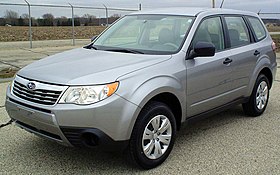 | |
| Overview | |
| Production | 2007–2012 |
| Powertrain | |
| Engine |
|
| Transmission | |
| Dimensions | |
| Wheelbase | 2,616 mm (103 in) |
| Length | 4,559 mm (179.5 in) |
| Width | 1,781 mm (70.1 in) |
| Height | 1,674 mm (65.9 in) 1,742 mm (68.6 in) (2010-2012 2.5X/XT) |
| Curb weight | 1,470 kg (3,250 lb) |
The third generation Forester began to move away from a traditional wagon design towards becoming a crossover SUV. It was larger in nearly every dimension and featured a sloping roof line with more cargo space. Subaru unveiled the model year 2008 Forester in Japan on December 25, 2007. The North American version made its debut at the 2008 North American International Auto Show in Detroit.
Styling was by Subaru Chief Designer Mamoru Ishii.[11] The dimensions derive from engineers using the basic body structure of the Japanese-spec Impreza wagon with the rear platform of the U.S.-spec Impreza sedan.[11] The Forester's wheelbase was increased 3.5 inches (89 mm), with overall increases of 3.0 inches (76 mm) in length, 1.8 inches (46 mm) in width and 4.3 inches (110 mm) in height.[11]
The independent double wishbone rear suspension was redesigned for better handling and a smoother ride. A "Sportshift" mode was added to the four-speed computer-controlled automatic transmission. The in-dash, touch-screen satellite navigation system became Bluetooth compatible, and integrated with a premium stereo. A six-speaker surround sound enhancement was optional.
The new model added 3.5 inches (89 mm) to the Forester's wheelbase, improving interior space and cargo room (31 cu ft (0.88 m3) expandable to 69 cu ft (2.0 m3)). Ground clearance was 8.9 inches (230 mm).
Europe[edit]
The Forester was available in Europe from 2008 with either the 2.0-liter EJ20 (150 hp; 110 kW) 196 Nm petrol engine with Active Valve Control System (AVCS) matched to either five-speed manual or four-speed automatic gearbox, or an all-new diesel-powered horizontally opposed Subaru EE boxer engine, and six-speed manual gearbox. The new model was introduced at the 2008 Paris Motor Show in October.[12] The diesel engine produces a power output of 147 PS (108 kW; 145 hp) and 350 Nm.
In the UK, the petrol-powered Forester was offered in the popular X and XS models, while trim level for the diesel models were X, XC, and XS NavPlus.
In Russia, Belarus and Ukraine 2.5 and 2.5 Turbo engines were also available.
In Netherlands the Forester is offered with petrol or diesel engines. The petrol engine can also be fitted with an additional liquefied petroleum gas installation (LPG), usually an aftermarket installation provided directly through dealerships. The available equipment levels are Intro (petrol engine only), Comfort, Luxury, and Premium. Maximum towing abilities for the petrol or petrol with LPG are 2000 kg (manual) or 1500 kg (auto), while the manual-only diesel can tow 2000 kg.
Australia[edit]
There were seven specifications with various trim and performance levels:[13]
- X: Base model - naturally aspirated 2.5 L flat-4, 126 kW (169 hp) 229 Nm (169 ft-lbf)
- XS: Lower luxury non-turbo model - naturally aspirated 2.5 L flat-4, 126 kW (169 hp) 229 Nm (169 ft-lbf)
- XS Premium: luxury non-turbo model - naturally aspirated 2.5 L flat-4, 126 kW (169 hp) 229 Nm (169 ft-lbf)
- 2.0 Diesel: turbo-diesel 2.0 L flat-4, 108 kW (145 hp) 350 Nm (258 ft-lbf)
- 2.0 Premium Diesel: Premium - turbo-diesel 2.0 L flat-4, 108 kW (145 hp) 350 Nm (258 ft-lbf)
- XT: Lower luxury turbo model - turbocharged 2.5 L flat-4, 169 kW (227 hp) 320 Nm (236 ft-lbf)
- XT Premium: luxury turbo model - turbocharged 2.5 L flat-4, 169 kW (227 hp) 320 Nm (236 ft-lbf)
- S-Edition: - turbocharged 2.5 L flat-4 193 kW (259 hp) 347 Nm (256 ft-lbf)
Summary of standard trim and equipment over different Australian models.
- Wheels and tyres – The X model came with 16-inch steel wheels, the 2.0 diesel model with 16-inch alloys, all other models came with 17-inch alloy wheels. The S-Edition comes with STI style wheels.
- Suspension – The X model came with double wishbone type, independent rear suspension. All other models came with self-levelling double wishbone type, independent suspension on the rear.
- Miscellaneous – The Premium versions of the 2.0 diesel, XS and XT models came with leather seating and an electric sunroof. These items were not available as options on other models.
- Transmission. The X came with either a dual range, five-speed manual transmission or a four-speed automatic transmission. Both diesel models come with a six-speed manual transmission only. All other models came with either a single-range, five-speed manual or four-speed automatic transmission. The S-Edition has a 5 speed Automatic Transmission.
- Entertainment – The XT Premium came with a multi-information in-dash satellite navigation system and single CD/DVD player (7-inch touch screen). The X and 2.0 diesel came with an AM/FM radio, CD player (MP3 and WMA compatible), four-speaker stereo (tweeters and subwoofer optional extra). All other models came with an AM/FM radio, six-stack in-dash CD player (MP3 and WMA compatible), and a six-speaker SRS stereo system with subwoofer. The system from the XT Premium was optional on all other models, but cost A$4851.50 (fitted).[15]
United States[edit]
The Forester trim levels were the 2.5X, the 2.5X Premium, the 2.5X Limited and the 2.5XT and 2.5XT Limited both with turbo. The interior color was either black or light gray, with three upholstery selections, including leather.[16] Nine exterior colors were offered, with four colors in a pearlescent appearance.
Starting July 2009, Subaru no longer offered a special-edition L.L. Bean trim level on the Forester.[17]
The USA 2.5X model was certified PZEV emissions (Rated 175 hp (130.5 kW) instead 170 hp (126.8 kW)), with a badge attached to the rear of the vehicle on the bottom right-hand side of the tailgate. All other USA models were certified LEV2. The PZEV Forester was available for sale in all fifty states, unlike other manufacturers who only sold PZEV-certified vehicles in states that had adopted California emission standards. The engine without the turbo runs on unleaded gasoline rated at 87 octane, and the turbo engine (EJ255) requires premium fuel rated minimum 91 octane.
Safety equipment included front airbags with side curtain airbags and front passenger side airbags (for a total of six airbags) and brake assist that detects panic-braking situations and applies maximum braking force more quickly. The five-speed manual transmission was equipped with Incline Start Assist.
Some of the standard equipment found on the 2.5X included Subaru's VDC (Vehicle Dynamics Control), 16 inch steel wheels, and an auxiliary audio jack for MP3 players. Optional equipment included 17 inch alloy wheels, panoramic moonroof, heated front seats and heated side-view mirrors. The L.L. Bean edition added automatic climate control, leather upholstery, an upgraded stereo with six speakers and a six disc in-dash CD changer over the four-speaker stereo with single disc CD player, and an in-dash navigation system, as well as L.L. Bean signature floor mats and rear cargo tray.
The 2.5 XT came with the premium stereo standard, as well as 17-inch alloy wheels, and the panoramic moonroof. The 2.5 XT Limited added leather upholstery with heated front seats, in-dash navigation, a rear spoiler, and automatic climate control. For 2009, XT models came only with a four-speed automatic with Sport Shift.
Forester XTI concept[edit]
The Forester XTI concept vehicle used the 2.5-liter intercooled turbo engine from the Subaru WRX STI, six-speed manual transmission, 18 × 8-inch S204 forged alloy wheels with Yokohama Advan Neova 255/40R18 performance tires, adjustable coil-over suspension, Brembo brakes with four-piston front calipers, 2-piston rear calipers, Super Sport ABS and Electronic Brake-force Distribution (EBD), leather and Alcantara sport seats, a special instrument cluster, front dash and center console and leather-wrapped steering wheel. Engine is rated 315 hp (235 kW) and 300 lb⋅ft (407 N⋅m) torque.
The vehicle was unveiled in the 2008 SEMA Show.[18]
Mountain Rescue Vehicle[edit]
Subaru produced a specialized vehicle for the National Ski Patrol based on the 2.5XT turbo.[19] It includes diamond plate floor, rear steel walls, a 9,500-pound winch and a roof-mounted toboggan. The vehicle was unveiled in the 2008 SEMA Show.[20][21]
Facelift[edit]
In 2010 for the 2011 model year, the Subaru Forester received a new grille insert. An optional roof-rack would raise total height by 2.5 inches. The naturally aspirated Foresters were equipped with an all new third generation motor with SOHC 2.5l EJ25 and 2.0l flat four EJ20.
Gallery[edit]
Pre-facelift styling
Post-facelift styling
Fourth generation (SJ, 2012–2018)[edit]
| Fourth generation | |
|---|---|
_–_Frontansicht,_1._März_2014,_Wuppertal.jpg) | |
| Overview | |
| Production | 2012–2018 |
| Powertrain | |
| Engine |
|
| Transmission |
|
| Dimensions | |
| Wheelbase | 103.9 in (2,640 mm) |
| Length | 180.9 in (4,595 mm) |
| Width | 70.7 in (1,796 mm) |
| Height | 68.2 in (1,732 mm)[22] |
| Curb weight | 1,495 to 1,686 kg (3,296 to 3,717 lb) |
The fourth-generation Forester was unveiled in the 2012 Guangzhou Motor Show,[23] followed by the 2013 New York International Auto Show.[24]
Changes to the line-up include:
- Continuously Variable Transmission (CVT) and decreased towing capacity. Maximum towing capacity was reduced to 1,500 lb (680 kg) across all trim lines (in the United States; overseas the towing capacity is double that). Turbocharged variants use a high-torque CVT with steering wheel paddle shifter controls.
- Revised, sport-oriented suspension, wheels (18-inch) and chassis bracing for XT (turbo) variant, providing flatter cornering in turns and better handling overall with little impact on ride.
- Increased fuel economy, up to 32 mpg (7.35 L/100 km) highway (EPA rated)
- 1.4 inches longer, 0.6 inches wider, 1 inch longer wheelbase
- Increased interior volume: rear seat legroom is 41.7 inches (1,060 mm) and rear cargo volume (with seats folded down) is 74.7 cubic feet (2.12 m3).[25]
- New option on higher end CVT models is "X-MODE" AWD control system, which was developed for driving on uneven or slippery road conditions. Engine, Transmission and VDC are controlled cooperatively.[26][27]
- New option on top of the line 2.5i and 2.0XT Touring models only: EyeSight Driver Assist System
Japan models went on sale in November 2012. Early model includes 2.0i, 2.0i-L, 2.0i-L EyeSight, 2.0i-S EyeSight, 2.0XT (280 PS), 2.0XT EyeSight (280 PS).[28] 2.0i engine models include six-speed manual (2.0i, 2.0i-L) or Lineartronic CVT transmission; 2.0XT (280 PS) engine models include Lineartronic CVT transmission.[29]
Asian models went on sale in March 2013 as 2014 model year. Early model includes 2.0i-L, 2.0i Premium and 2.0XT. ASEAN production of the Subaru Forester began in February 2016. Malaysia-based Tan Chong Motor Assemblies (TCMA) will assemble approximately 10,000 Forester units annually for Malaysia, Thailand and Indonesia respectively.[1]
US models went on sale in March 2013 as 2014 model year vehicles. Early models include 2.5i in base, Premium, Limited and top-line Touring versions, and performance-oriented turbocharged 2.0XT (253 PS) in Premium and Touring versions. Base and Premium model 2014 Foresters can be equipped with the manual six-speed transmission or the Lineartronic CVT. All other models are equipped with the Lineartronic CVT. An option on Limited/Touring 2.5i and Premium/Touring 2.0XT is new X-Mode control and Hill Descent Control (HDC) features. These are not available on other models.
Safety[edit]
According to IIHS (Insurance Institute for Highway Safety) the 2014 Forester achieved Good crash test ratings in Small Overlap Front, Moderate Overlap Front, Side, Roof Strength, and Head Restraining & Seats categories. The Forester had not been rated Good in the Small Overlap Front test until modifications were made for the 2014 model year. The small overlap test, introduced in 2012 by the IIHS, simulates a frontal collision on 25 percent of the driver's side front corner. Since its adoption, the IIHS has noticed several automakers making non-symmetrical modifications to their vehicles. Another small overlap test was conducted on a number of vehicles, including a 2014 Forester, but was conducted on the passenger side instead. The crash test showed substantially more intrusion into the passenger side than into the driver's side of the Forester, it would have been rated Marginal[30][31]
X Mode[edit]
The 2014 Forester has a new feature called X Mode that allows owners to go through more extreme conditions both on the road and off. The concept is that any driver, regardless of skill level, can drive safely on wet roads or muddy areas. It works by monitoring wheel-slip on all four wheels; should one or more wheels begin to slip, X Mode kicks in and applies the brakes to the affected wheel which results in a transfer of power to the opposite wheel. After it is engaged by a simple push button, X Mode stays engaged up until the vehicle's speed is about 25 mph (40 km/h) then disengages itself.[32]
EyeSight Driver Assist System[33][edit]
The 2014 top-of-the-line Touring model Forester offers Subaru's EyeSight[34] driver assist technology that uses stereoscopic CCD cameras mounted on either side of the rearview mirror. Eyesight offers several driver assist technologies/features which include:
- Pre-Collision Braking System
- Pre-Collision Throttle Management
- Adaptive Cruise Control
- Lane Departure and Sway Warning
The system can be manually turned on or off. Being an optical, instead of radar, based system, it has limitations in limited visibility situations; driving into the sun, fog, or where the windshield is not cleared (snow, mud, etc.) may cause the system to disengage.
Engines[edit]
| Model | Years | Type/code | Power/rpm, Torque/rpm |
|---|---|---|---|
| 2.5i | 2014-2018 | 2,498 cc (152.4 cu in) H4 (FB25) | 172 PS (127 kW; 170 hp) at 5,800, 24.1 kg⋅m (236 N⋅m; 174 lbf⋅ft) at 4,100 |
| 2.0XT (253 PS) | 2014–2018 | 1,998 cc (121.9 cu in) H4 (FA20F) | 253 PS (186 kW; 250 hp) at 5,600, 35.7 kg⋅m (350 N⋅m; 258 lbf⋅ft) at 2,000-4,800 |
| 2.0XT (280 PS) | 2014–2018 | 1,998 cc (121.9 cu in) H4 (FA20F) | 280 PS (206 kW; 276 hp) at 5,700, 35.7 kg⋅m (350 N⋅m; 258 lbf⋅ft) at 2,000-5,600 |
The 2014 and 2015 models had a major revamp of interior comfort. The passenger seat is higher, the sound system has been upgraded, the rear bench seats are higher and the console is re-positioned for the person riding in the center. The manual transmission models were also upgraded to a six-speed transmission instead of the previous generation's five-speed transmission. Engines during these year models do have an issue, this seems to be related predominantly to US manufactured vehicles and Subaru Australia have had no significant issues with excess oil consumption in Australia with the Japanese manufactured vehicles.(Source Subaru Australia and extensive research prior to purchase by Australian customer (KRH))[original research?] with oil consumption, along with numerous other automotive manufactures at the time. Subaru had its settlement of a lawsuit approved by a US Court in August 2016.[35] The US complainants experienced over 1.5 quarts of oil consumed between change intervals with low-level dash lights coming on. The settlement provided for such complainants to receive an extended eight year warranty on the engine, allowing for an engine rebuild for that excessive oil consumption. Some speculation on this is the use of different style piston rings on the engine style change and synthetic oil.[according to whom?]
Pre-facelift styling
Post-facelift styling (2017–2018)[36]
Fifth generation (SK, 2018-present)[edit]
| Fifth generation | |
|---|---|
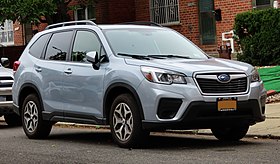 | |
| Overview | |
| Production | 2018–present |
| Powertrain | |
| Engine |
|
| Transmission | Lineartronic CVT |
| Dimensions | |
| Wheelbase | 105.1 in (2,670 mm) |
| Length | 182.1 in (4,625 mm) |
| Width | 71.5 in (1,815 mm) |
| Height | 68.1 in (1,730 mm)[37][38] |
| Curb weight | 1,564 to 1,627 kg (3,449 to 3,588 lb) |
The 2019 Subaru Forester was revealed on March 28, 2018 at the New York International Auto Show.[38] Like contemporary Subaru models, the 2019 model year moved the Forester to the Subaru Global Platform.
In the US market, the 2019 Subaru Forester is available in the following trims:
- Forester
- Forester Premium
- Forester Sport
- Forester Limited
- Forester Touring
As with all auto makers, each trim comes with a different level of standard features. The 2019 model year also comes standard with 8.7 inches (22 cm) of ground clearance.
Mechanical features[edit]
All 2019 Subaru Foresters have one of three versions of Subaru's Symmetrical All Wheel Drive (AWD) system. The trim level determines which system is installed. All provide a nominal torque split biased 60 front to 40 rear.
- Base: Variable Torque Distribution (VTD) utilizing electronically controlled clutches to control torque split.
- Premium: enhanced “X-Mode” which is a Single Mode System that optimizes engine output and transmission ratio. It enhances control of the VDC system to further control wheelspin and incorporates Hill Descent Control (HDC).
- Sport, Limited and Touring: further enhanced “Dual Function X-Mode” System that adds specific, user engaged, settings for Snow/Dirt and Deep Snow/Mud modes.
For the first time, all trim levels of Forester are only available with one engine: Subaru's new FB25 DI. The engine is a non-turbo, direct injection flat (boxer) 4 cylinder producing 182 hp (136 kW) at 5800 rpm and 176 lb⋅ft (239 N⋅m) at 4400 rpm.[39] There is also only a single transmission option: the Lineartronic CVT.[40]
Safety[edit]
All Foresters come standard with Subaru's Eyesight Driver Assistance Technology.[39]
For the first time Subaru DriverFocus™ Distraction Mitigation System comes standard on the Touring trim, which provides an alert when it detects the driver is distracted or is drowsy. In addition, the DriverFocus system is able to recognize five different drivers and will set seat and mirror positions and climate control settings accordingly.[39]
In 2019, the Start/Stop feature was added to all Forester models. This feature turns off the engine when the brake pedal is pressed. The engine restarts only after the gas pedal is pressed. This feature comes on by default every time the engine is turned on but may be disabled after the engine is on.
e-BOXER[edit]
Subaru introduced the e-BOXER hybrid powertrain for the European-market Forester and XV at Geneva in March 2019; the e-BOXER integrates an electric motor into the Lineartronic CVT to improve fuel economy and increase power.[41] The e-BOXER powertrain features a modified FB20 rated at 110 kW (148 hp; 150 PS) at 5,600–6,000 rpm and 194 N⋅m (143 lb⋅ft) of torque at 4,000 rpm. Like the first-generation XV Crosstrek Hybrid, the Forester e-BOXER adds a single electric motor rated at 12.3 kW (16.5 hp; 16.7 PS) maximum output.[42] The battery for the traction motor is placed above the rear axle, improving the front/rear weight balance.[43]
Awards[edit]
- Car and Driver's 5Best Trucks 2004,[44] 2005,[45] 2006[46]
- Winner of Wheels Gold star cars award for best compact SUV 2008[47]
- Winner of Motor Trend magazine's Sport/Utility of the Year Award in 2009[48]
- Best Small Utility in MotorWeek's 2009 Driver's Choice Awards[49]
- Winner of Motor Trend Magazine's SUV of the Year Award in 2014[50]
- Insurance Institute for Highway Safety Top Safety Pick+[51]
- Subaru Forester Claims Top Honours as AJAC's 2017 Canadian Utility Vehicle of the Year
Sales[edit]
| Calendar Year |
Canada[52] | Thailand | United States[52] |
|---|---|---|---|
| 2004 | 4,204 | N/A | 6,568 |
| 2005 | 3,614 | 53,541 | |
| 2006 | 3,737 | 51,258 | |
| 2007 | 3,303 | 44,530 | |
| 2008 | 6,322 | 60,748 | |
| 2009 | 8,638 | 77,781 | |
| 2010 | 8,941 | 85,080 | |
| 2011 | 8,673 | 76,196 | |
| 2012 | 7,156 | 80,356 | |
| 2013 | 11,239 | 123,592 | |
| 2014 | 12,302 | 105[53] | 159,953 |
| 2015 | 12,706 | 129[54] | 175,192 |
| 2016 | 13,798 | 1,468[55] | 178,593 |
| 2017 | 13,441 | 939[56] | 177,563 |
| 2018 | N/A | 749 | 171,613 |
| 2019 | 2,366[57] | 180,179[58] |
References[edit]
- ^ Jump up to: a b Gerard Lye (February 26, 2016). "2016 Subaru Forester CKD production begins in Malaysia – two variants scheduled for Q2 2016 launch". Driven Communications. Archived from the original on March 27, 2016. Retrieved March 27, 2016.
- ^ "2014 Subaru Forester". TheCarConnection.com. Retrieved March 30, 2017.
- ^ "Subaru Forester". Edmunds.com. August 11, 2010. Retrieved May 5, 2012.
- ^ "Symmetrical AWD" SUBARU GLOBAL Archived December 10, 2014, at the Wayback Machine
- ^ "Subaru Forester SUV - Subaru Forester India - Subaru Forester Features & Specifications". Iloveindia.com. Retrieved July 29, 2010.
- ^ "I Chevrolet. I Chevrolet In India". Car-cat.com. Retrieved July 29, 2010.
- ^ "Chevrolet Forester Review - Chevrolet Forester India, Chevrolet Forester Features & Specifications". India-server.com. Retrieved July 29, 2010.
- ^ "Subaru Forester 2003-2008 review". Samarins.com. Retrieved April 3, 2009.
- ^ "International Engine of the Year Award - 2.0L to 2.5L category". Archived from the original on March 18, 2006.
- ^ "Subaru Australia's announcement of winning the International Engine of the Year award".
- ^ Jump up to: a b c "First Drive: 2009 Subaru Forester: Now It's a Crossover, Not a Wagon". Edmunds.com, Peter Lyon, January 20, 2008. Archived from the original on May 14, 2008.
- ^ "Paris Preview: Subaru debuts boxer diesel Forester and Impreza". autoblog.com. Retrieved April 3, 2010.
- ^ Prices as of December 2008[citation needed]
- ^ "Subaru Forester - Subaru Australia". Subaru.com.au. February 9, 2009. Retrieved December 10, 2010.
- ^ "Subaru Forester X Wagon - Accessories - Subaru Australia". Subaru.com.au. Retrieved December 10, 2010.
- ^ Subaru of America Forester sales brochure, printed March 2008
- ^ "Subaru and L.L.Bean Part Company". blogs.cars.com. Retrieved April 3, 2010.
- ^ Korzeniewski, Jeremy (October 31, 2008). "SEMA Preview: Subaru to show off Forester XTI and Mountain Rescue Vehicle". Autoblog.com. Retrieved December 10, 2010.
- ^ "AfterMarket Mayhem: 2008 SEMA Show Photos & Coverage Part 1". Trucktrend.com. February 26, 2007. Archived from the original on June 4, 2011. Retrieved December 10, 2010.
- ^ Ramsey, Jonathon (November 5, 2008). "SEMA: Save us Subaru Mountain Rescue Vehicle!". Autoblog.com. Retrieved December 10, 2010.
- ^ "Subaru Forester Mountain Rescue Concept Ascending To SEMA". jalopnik.com. Retrieved April 3, 2010.
- ^ "The 2017 Subaru Forester". Subaru.com. Retrieved March 30, 2017.
- ^ "富士重工業株式会社 ニュースリリース". FHI.co.jp. Retrieved March 30, 2017.
- ^ Ross, Jeffrey N. "2014 Subaru Forester finally steps in front of the camera". Autoblog.com. Retrieved March 30, 2017.
- ^ "Review: 2014 Subaru Forester". Automoblog.net. Retrieved May 13, 2013.
- ^ "Subaru Forester (2014) - Netcarshow".
- ^ "スバル、新型フォレスターを発表".
- ^ "富士重工業株式会社 ニュースリリース". FHI.co.jp. Retrieved March 30, 2017.
- ^ "富士重工業株式会社 ニュースリリース". FHI.co.jp. Retrieved March 30, 2017.
- ^ "Vehicles with good driver-side protection may leave passengers at risk". Insurance Institute for Highway Safety.
- ^ https://www.nytimes.com/2016/06/24/automobiles/risks-higher-for-front-seat-passengers-in-some-suv-crashes-tests-show.html
- ^ "Subaru Lab Episode 5 - X Mode". Byers Dublin Subaru.org. April 8, 2013.
- ^ "Subaru Eyesight Overview". Subaru.com. June 27, 2012.
- ^ "Spotlight On: Subaru Eyesight". leftlanenews.com. February 14, 2013.
- ^ https://www.classlawgroup.com/subaru-oil-consumption-class-action-lawsuit/
- ^ "2017 Subaru Forester Gets Minor Updates – News – Car and Driver". Caranddriver.com. April 14, 2016. Retrieved June 20, 2019.
- ^ "2019 Forester Specifications". US Media Center. Retrieved January 10, 2019.
- ^ Jump up to: a b "World Premier of All-New 2019 Forester at New York International Auto Show" (Press release). Subaru Corporation. March 29, 2018. Retrieved April 3, 2019.
- ^ Jump up to: a b c "2019 Forester: Features". Subaru of America. Retrieved April 5, 2019.
- ^ "Choose Your 2019 Forester". Subaru of America. Retrieved April 5, 2019.
- ^ "Subaru unveiled European-spec "e-BOXER" equipped models at Geneva International Motor Show" (Press release). Subaru Corporation. March 5, 2019. Retrieved April 3, 2019.
- ^ "Specifications – Subaru Forester e-BOXER (European specs.)" (PDF). Subaru of Europe. Retrieved April 4, 2019.
- ^ "Hybrid, the Subaru way: Introducing our all-new all-powerful e-BOXER range". Subaru of Europe. Retrieved April 3, 2019.
- ^ "2004 5Best Trucks". Car and Driver. March 2004.
- ^ "2005 5Best Trucks". Car and Driver. March 2005.
- ^ "2006 5Best Trucks". Car and Driver. March 2006.
- ^ "Forester is Gold Star Car - Wheels Magazine Review". Jarvis Subaru. 2008.
- ^ "2009 Motor Trend Sport/Utility Of The Year: Subaru Forester". Motor Trend. December 2008.
- ^ "Chicago 2009: MotorWeek Drivers' Choice Best of the Year Award goes to VW Jetta TDI". Autoblog. February 11, 2009.
- ^ "2014 Motor Trend SUV of the Year: Subaru Forester". Motor Trend. December 2013.
- ^ "Subaru Forester". iihs.org. November 5, 2013.
- ^ Jump up to: a b Cain, Timothy. "Subaru Forester Sales Figures". goodcarbadcar. Retrieved April 5, 2019.
- ^ "Thailand cars sales report 2014". HeadlightMag.com. Thailand. Retrieved October 24, 2018.
- ^ "Thailand cars sales report 2015". HeadlightMag.com. Thailand. Retrieved October 24, 2018.
- ^ "Thailand cars sales report 2016". HeadlightMag.com. Thailand. Retrieved October 24, 2018.
- ^ "Thailand cars sales report 2017". HeadlightMag.com. Thailand. Retrieved October 24, 2018.
- ^ "Sales Report ยอดขายรถยนต์ กลุ่ม Compact SUV (C-SUV) : เดือน มกราคม – ธันวาคม 2019". HeadLight Magazine (in Thai). February 12, 2020. Retrieved February 12, 2020.
- ^ "Subaru of America, Inc. Announces December 2019 Sales; Sets Eleventh Consecutive Annual Sales Record" (Press release). Subaru of America, Inc. January 3, 2020. Retrieved February 18, 2020.
External links[edit]
| Wikimedia Commons has media related to Subaru Forester. |
| show |
|---|
| show « previous — Subaru, a division of Subaru Corporation, vehicle timeline in North America, 1990s–present
|
|---|
_Limited_wagon_(2011-10-31)_02.jpg)
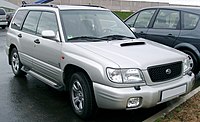
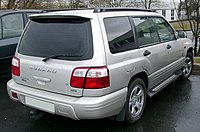
_GT_wagon_(2015-07-10)_01.jpg)

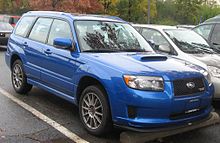


.jpg)
_X_wagon_(2010-10-19)_03.jpg)
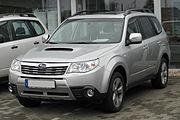
_XS_Premium_wagon_(2010-10-19)_02.jpg)
_–_Frontansicht,_10._Juni_2012,_Wuppertal.jpg)
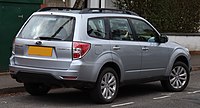

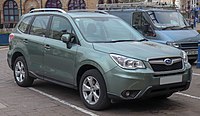
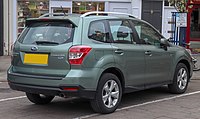

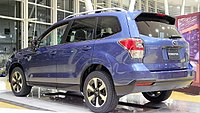
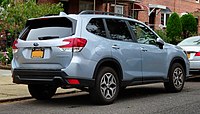
_in_Crystal_White,_rear_left.jpg)